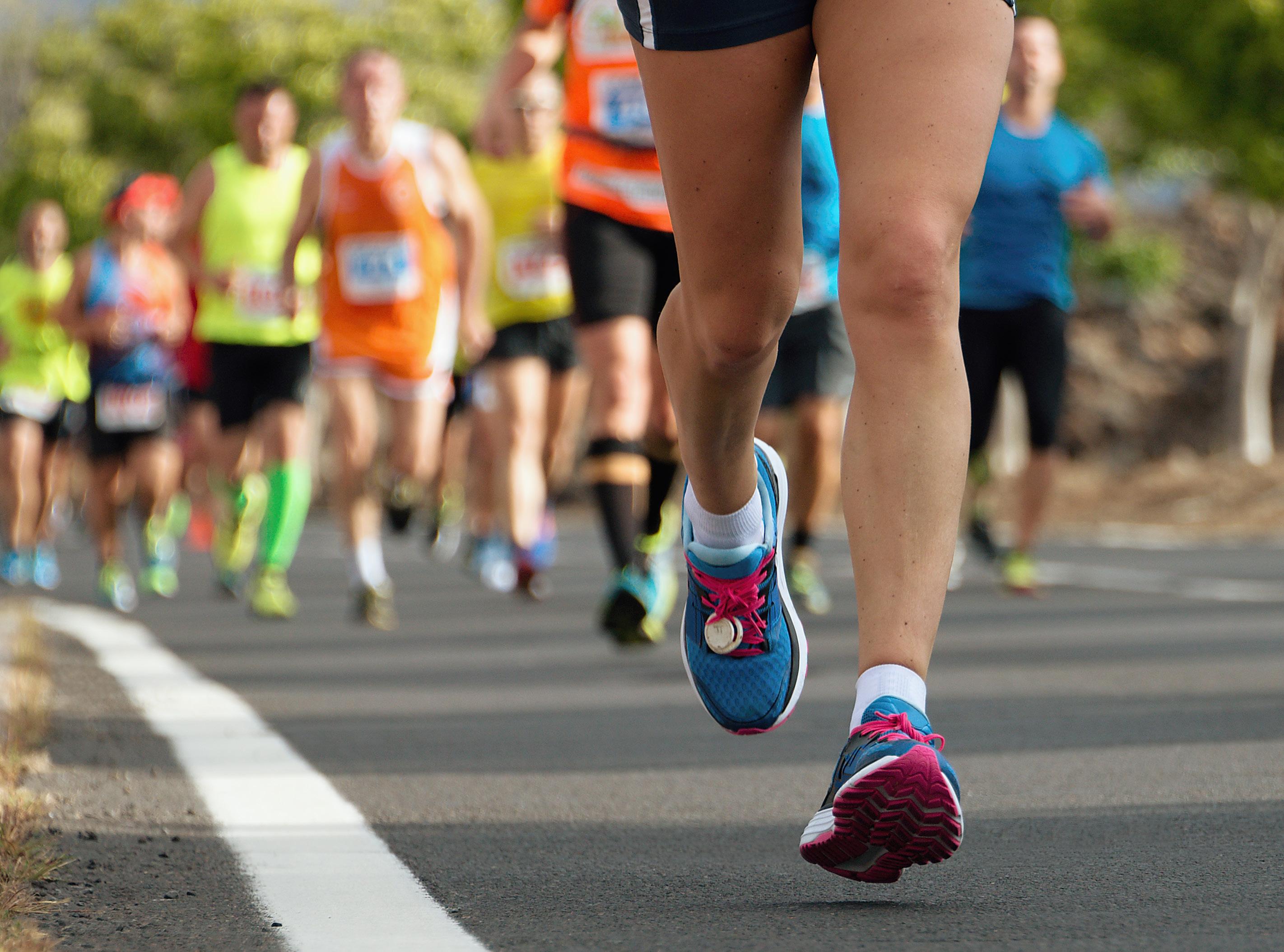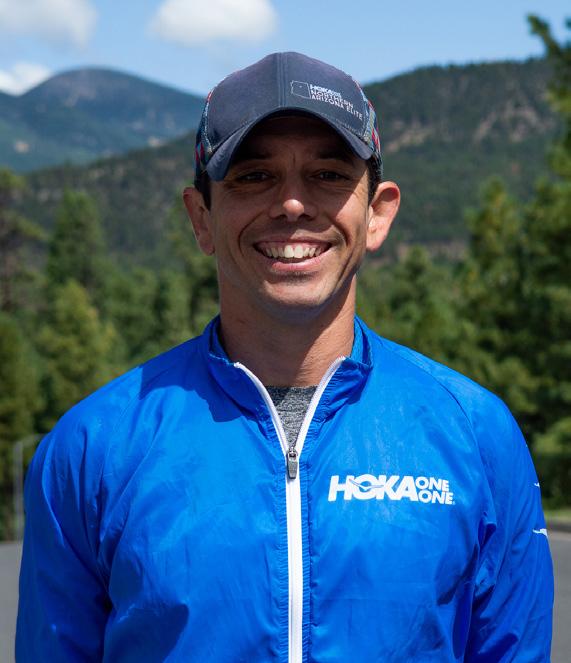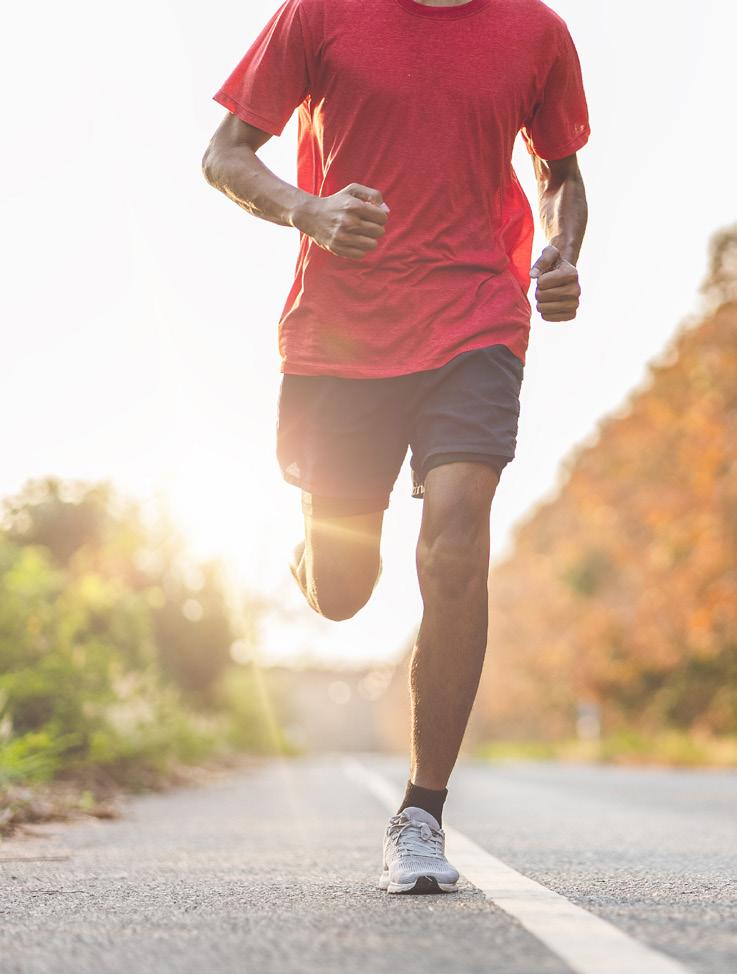Running Coach Certification



The UESCA Running Coach Certification is the most comprehensive running coach certification on the market. The certification was developed in partnership with many expert contributors, including professional runner and coach, Nell Rojas and former professional runner and executive director of the Hoka Northern Arizona Elite professional running team, Ben Rosario. In addition to our expert contributors, much of the certification content is the result of sourcing and reviewing hundreds of peer-reviewed research papers to source the latest and most accurate information.

Ben is the executive director and former head coach of the HOKA Northern Arizona Elite (NAZ Elite) professional running team - one of the country’s most decorated professional groups. The NAZ Elite athletes have produced 12 National Titles, ten top-10 finishes at World Marathon Majors, won five International Medals, and one Olympic Trials Marathon victory.

A former professional athlete for the Hanson’s Brooks Distance Project from 2003 to 2005, Ben was the youngest qualifier for the 2004 Olympic Trials Marathon. He then spent a year as the special events director for the GO! St. Louis Marathon before co-founding Big River Running Company, a run specialty store in Saint Louis. During that time Ben coached hundreds of athletes of all ages and abilities and directed dozens of events including the USATF Cross Country National Championships.
Nell Rojas was born and raised in Boulder, CO where she now trains professionally and coaches all ages and abilities. She competed in track and field and cross country at the University of Northern Arizona where she earned a B.S in Exercise Science and won numerous conference titles in the steeplechase and 5k. After college, she tried her hand at being a professional triathlete before retiring to go back to her roots of running. She won Grandma’s Marathon in 2019, went on to finish 9th at the Marathon Olympic Trials, and was the first American to cross the finish line at the Boston Marathon in 2021 and 2022, putting her in 6th and 10th place, respectively. She is now training to earn a spot on the 2024 Olympic Marathon Team.
∞ Bob Seebohar RD (Nutrition)
∞ Alexandra Coates Ph.D (Overtraining and Physiology)

∞ Justin Ross Psy.D (Sports Psychology)
∞ Leah Roberts MD (Female Physiology)
∞ Corrine Malcolm MS (Environmental Physiology)
∞ Jim Lehman MS (Program Design)
United Endurance Sports Coaching Academy (UESCA) is the leader in endurance sports coaching education. Established in 2014, the goal of UESCA is to raise the standard of endurance sports education by producing the highest-quality, science-based content via researching the latest and most pertinent research and by selecting top experts across various disciplines to provide content.
Just as important, we strive to provide exceptional customer service and support to those thinking of purchasing a certification, and to our existing coaches.


Likely due to its popularity, running tends to have more biases and myths associated with it than most other sports. As such, like our other certifications, the genesis of our certification content is science and evidence-based to ensure that we’re only producing accurate content. We accomplish this by reviewing the most up-to-date research, and by partnering with the top experts in the areas that we cover.

In short, you’ll learn everything needed to coach runners of all distances from the mile to the marathon. You’ll learn how the body functions with respect to the musculoskeletal and energy systems, as well as running biomechanics. Using this foundational knowledge, you will learn how to apply it on an individual basis in a wide range of areas to work with runners of all levels.
∞ Module 12: Athlete Intake
∞ Module 13 : Goal Setting





∞ Module 14: Female Physiology and Training
∞ Module 15: Periodization and Program Development

∞ Module 16: Pacing
∞ Module 17: Mental Training
∞ Module 18: Sports Nutrition
∞ Module 19: Safety
∞ Module 20: Running Shoes and Apparel
∞ Module 21: Race Preparation and Execution
∞ Module 22: Keeping It Legal
UESCA helps me provide my athletes with the ‘why’ behind how they train. Understanding why you’re training a specific way makes all the difference.
— Rachel LaymonI’ve read a lot of running literature over the past 10 years but I still learned a huge amount of new information about running performance and injury prevention when I completed the UESCA course.
— Josephine AnselinI love knowing the “why” behind the science of running - the detailed anatomy/biomechanics of the human body, nutrition, prescribing a training plan, etc... I feel like it’s complete knowledge to being a superior Run Coach. Also, the support from my fellow UESCA coaches is top notch!
 — Melissa Hopper
— Melissa Hopper
∞ Certification Structure
∞ No Tiers
∞ Running Certification Principles
∞ Content Delivery
∞ Content Providers
∞ Introduction
∞ Traits of a Coach
o Leader
o Motivator
o Disciplinarian
o Operations Manager
o Instructor and Educator
o Professional
o Honesty
o Verbal and Physical Actions
o Stay Current
o Effective Communicator
» Phone
» Text
» Timeliness
» Sensitivity
» Boundaries
∞ Areas of Study a Coach Must Understand
o Psychology
o Physiology
∞ Coaching Fallacies
o You Must Be Fast
o Holding Out Information
o An Extensive Race Resume’
o Everyone Responds the Same Way to Training Stimuli
∞ Factors of Athlete Success
∞ Most Common Running Mistakes
∞ Objectives
∞ Directional Terminology
∞ Skeletal System
∞ Landmark Terminology
∞ Spine
o Neutral Spine
» Cycling Application
o Lumbar Spine
o Spinal Abnormalities
o Injury
∞ Pelvis
» Spondylolisthesis
» Spinal Stenosis
» Radiculopathy
o Areas of the Pelvis
∞ Joints
o ‘Cracking’ Joints
∞ Foot and Ankle Complex
o Joints
∞ Genetic Factors
∞ Metatarsalgia
∞ Summary
∞ Objectives
∞ Muscular Physiology
o Terminology
o Skeletal Muscle Structure
o Contractile Properties
» Myofibrils
» Sarcomeres
» Actin and Myosin
o Myonuclei and Satellite Cells
o Muscle: Origin and Insertion
o Muscle Fiber Types
» Types
» Myostatin
o Muscle Fiber Recruitment
o Can Muscles Change Their Type?
» Muscle Hyperplasia vs. Muscular Hypertrophyo No Pain, No Gain?
o Relationship Between Muscle Fiber Type and Fat Metabolism
∞ Skeletal Muscle Function and Characteristics
o Muscle Memory
o Nerve Innervation
o Connective Tissue
o Fascia
∞ Muscles of the Body
o Anterior View
o Posterior View
o Muscle Classification
o Core Musculature
» Inner Core
» Outer Core
o Lower Body
o Upper Body
∞ Intramuscular Performance Factors
o Physiology of the Warm-Up
» Stretching vs. Warm Up – Are They the Same?
» Active vs. Passive
» Warm Up Guidelines
o Delayed Onset Muscle Soreness (DOMS)
» Potential Role of Estrogen on DOMS
» Cause of Muscle Soreness and Weakness
» Is a Cooldown Necessary?
» Use of NSAID’s to Counteract DOMS or Musculoskeletal Injury
o Muscle Burn
» What is Lactic Acid
» Training to Delay Onset of Blood Lactate Accumulation
o Exercise-Associated Muscle Cramps
∞ Muscle Synergy
o Kinetic Linking
» Effect of Glute Medius Weakness
o Muscle Imbalances
» Length/Tension Relationship
» Reduced Muscle Activation
» Muscular Compensation
» Workplace Postural Issues
∞ Summary
∞ Objectives
∞ Terminology
∞ Circulatory System
o Heart
o Blood Pressure
o Lungs
» Diaphragmatic Breathing
∞ Three Energy Systems
o Introduction to Energy Systems
» Cells
» Bioenergetics
o Anaerobic Alactic: ATP-CP System
o Anaerobic Lactic: Glycolysis
o Aerobic: Oxidative Phosphorylation
» Krebs Cycle
» The Electron Transport Chain
o Duration of Energy Systems
∞ Intensity-Based Fuel Sources
∞ Glucose
o Implication for Runners
o Muscle Glycogen Storage
∞ Glycolytic and Oxidative Relationship
∞ Fatty Acids
o Physiological Response to Aerobic Training
» Signs of Being Aerobically Deconditioned
o Hypoxic and Hyperoxic Training
» Hypoxic Training
∞ Blood Doping
» Effect of Supplemental Oxygen (Hyperoxic)
∞ Effects of Intense Exercise
o Glycogen Depletion
» Glycogen Depletion Training (GDT)
∞ Science/Reasoning Behind GDT
o Oxygen Debt
o ‘Out of Breath’
∞ Summary
∞ Heat
o Physiology of Heat Acclimation
o Heat Acclimation Considerations
» Pre-Race
» During a Race
∞ Humidity
∞ Heat Illness Overview
o Cramps
o Exhaustion
o Stroke
o Prevention
∞ Environmental Impact on the Gut
o Hyponatremia
o Dehydration
» Urine Color
» Determining Sweat Rate
∞ Cold
o Hypothermia
» Types
» Prevention
∞ Environmental Considerations and Lung Health
∞ Objectives
∞ Rate of Perceived Exertion (RPE)
o Perceived Exertion Assessment (PIA)
∞ Heart Rate
o Estimated Maximum Heart Rate
o Cardiac Drift
o Resting Heart Rate
o Recovery Heart Rate
o Heart Rate Training Zones
∞ VO2 Max
o Exercise Economy
» Cycling Specific Fitness
» Cycling Economy
» Relating VO2 Max to ‘Burning Fat/Calories’
» Why Not Assess VO2 Max?
o Assessing Maximal Heart Rate
» Testing Protocol
∞ Anaerobic Threshold: Fact or Fiction?
o Conconi Test
o Origin of Anaerobic Threshold
∞ Lactate Threshold
o Historical Reference
o Benchmarking Lactate Threshold
» MLSS-Associated Heart Rate
o Blood Lactate Clearance
» Training Implication
» Why Not Directly Test for Blood Lactate?
o Interpreting Lactate Threshold via Talk Test
» Rationale for Talk Test
» Talk Test Cycle Protocol
o Interpreting Lactate Threshold via MLSS
» Test Protocol for 30-Minute Cycle MLSS Time Trial
o Creating MLSS/Maximum Aerobic-Based Training Zones
o Training Zones
∞ Power
o Functional Threshold Power (FTP)
» Determining Power from MLSS Assessment
» Test Protocol for 30-Minute Cycle Time Trial
» Power-to-Weight Ratio
» Effect of Altitude on Power
o Maximal Aerobic Power (MAP)
» Assessment
o Training Zone Integration of FTP and MAP
∞ Summary
∞ Rate of Perceived Exertion (RPE)
o Perceived Exertion Assessment (PIA)
∞ Heart Rate
o Estimated Maximum Heart Rate
o Cardiac Drift
o Resting Heart Rate
o Recovery Heart Rate
o Heart Rate Variability
∞ VO2 Max
o Exercise Economy
» Sport Specific Fitness
» Running Economy
» Relating VO2 Max to ‘Burning Fat/Calories’
» Should You Assess VO2 Max?
o Assessing Maximal Heart Rate
» Testing Protocol
∞ Anaerobic Threshold
o Benchmarks
» Lactate Threshold
» Maximum Lactate Steady State
» Ventilatory Threshold
» Onset of Blood Lactate Accumulation
o Origin of Anaerobic Threshold
∞ Lactate Threshold
o Historical Reference
o Is Lactic Acid and Lactate the Same?
o Benchmarking Lactate Threshold
» MLSS-Associated Heart Rate
o Blood Lactate Clearance
» Training Implication
» Why Not Directly Test for Blood Lactate?
o Functional Threshold Heart Rate Assessment
» FTHR Assessment Protocol
∞ 20-Minute Test
∞ Training Zone Integration of FTHR
o Training Zone Integration of FTHR
o Training Zones
o Programming and Pacing
o Specific of Sport Disciplines
∞ Preferred Analysis Tools
∞ Emerging Technology
o Blood Analysis/Markers
o Constant Glucose Monitoring
∞ Introduction
∞ Terminology
∞ Gait Phases
∞ Ground Reaction Force
∞ Pronation and Supination
o Role of the Big Toe
» Big Toe Facts
» Shoe Implications
» Dysfunction
» Get Stronger and More Flexible
o Shoe Wear Patterns
∞ Pronation
∞ Overpronation
o Flat Feet
o What is a Q-Angle?
∞ Supination
∞ Assessing Pronation and Supination
o Visual Signs of Overpronation
o Visual Signs of Supination
o Injury Considerations
» Pronation is not Indicative of Predictive of Injury
o Knee Valgus
∞ Ankle Dorsiflexion
∞ Running Form Components
∞ Correct Form
∞ Assessing Form – Treadmill vs. Outdoors
o Benefits and Drawbacks of Treadmill Assessments
∞ Self-Selection of Running Form
∞ Passive Energy
o Stretch Shortening Cycle
» Tendons
∞ Achilles Tendon
o Mechanics
» Outside Influences
» Trainability
∞ Foot Arch
» Muscles
» Passive Movement
∞ Training Implications
∞ Allocation of Energy
∞ Rotational Driven Running
o The Spinal Engine
o Spinal Rotation
o Spiral Spring System
o Coupled Motion
» How Do the Spring Systems Work?
» Anterior and Posterior Spring Systems
o Arm Movement
o Range of Motion
o Relationship Between Spinal Rotation and Efficiency
» Elastic Response
» Cueing Hip Rotation and Shoulders
» Drill
∞ Relationship Between Ankle Flexibility and Hip Extension
∞ Foot Strike Type
o Is a Midfoot Strike Right for Everybody?
o Heel vs. Midfoot Strike
o Foot Strike Misnomer
o Midfoot Strike Drills
o Converting to Midfoot Form
» When Not to Make Changes
» Go Slower to Go Faster
∞ It’s All About the Tibia
o Drill
o Natural Foot Gait
o Foot Contact Time
o Form Analysis
∞ Stride Length and Rate
o Argument Against Changing Stride Length/Type
o Correlation Between Stride Rate and Length
o Stride Length
» Vertical Oscillation
o Stride Rate
» Conclusions
o Drills
∞ Biomechanical Running Assessments
∞ Injury Terminology
∞ Scope of Practice
∞ Team Approach
∞ Injury
o Scenarios
o Inhaler use
o Injury Prevalence and Location
o Influence of Foot Strike Type
o Anatomical Factors
o Is Running ‘Hard on the Knees?’
∞ Injury Prevention
o Volume Increases
o Intensity
o Cross-Training
o Fatigue
o Pre-Stretching?
o Kinesio Tape
o Running Shoe Selection
∞ Running Injuries
o What is Tendonitis?
o Common Causes of Running Injuries
o Running-Related Injuries
» IT Band Syndrome
∞ Friction Syndrome?
∞ Movement of IT Band
∞ Compression
∞ Training Implications
» Shin Splints
∞ Types
» Hamstring Injuries
» Ankle Injuries
» Popliteus Injury
» Plantar Fasciitis
» Side Stitch
» Metatarsalgia
» Morton’s Neuroma
» Sesamoiditis
» Bunion
∞ Running Recovery and Treatment
o Don’t Fix an Injury, Manage It
» Management
» Summary
o Ice?
o Peace and Love
o Anti-Inflammatory Drugs
o Starting Back Up
∞ Blisters
∞ Response to Injury
∞ Illness
o Colds and Flu
o Guidelines
∞ Why Resistance Training?
o Our Standpoint on Resistance Training
o Improve Running Economy
o Do it Right or Not at All
o Time Constraints
o Movement Planes
o Cardiovascular Fitness Precedes Musculoskeletal Readiness
∞ Myths Surrounding Resistance Training
∞ Physiology of Resistance Training
o Overload Principle
o Neuroendocrine Response
o Muscle Hierarchy
∞ Resistance Training Protocol
o Determining Workout Structure
o Strength – Endurance Continuum
o Alternate Resistance Training Duration Prescriptions
» Rate of Perceived Exertion (RPE)
» Time
» Areas of Focus
∞ Calves
∞ Feet
∞ Core (LPHC)
∞ Gluteals
o Plyometrics
» Correlation with the Stretch Shortening Cycle
∞ Programming
o Progression
o Structure
o Taper
o Muscle Specificity
o Concurrent Training
» Argument for and Against the Integration of Strength Training
» Effects of Strength Training Order
» Timing
∞ Introduction
∞ Foundation Exercises
∞ Running-Specific Exercises
∞ Sleep and Recovery
o Sleep Type
o What Affects Sleep Patterns?
o Health Issues
o Athlete Considerations
∞ Stretching
o Physiology
» Golgi Tendon Organ
» Muscle Spindle
o Elastic Response
o Types of Stretches
» Static
» Dynamic
» Ballistic
» PNF
o Primary Stretches
∞ Myofascial Release
o Maintain Properly Functioning Fascia
o Fascia Specialists
o Foam Roller
o Form Roller Applications
∞ Percussion Tools
∞ Objectives
∞ Athlete Screening
o Health Screening
» PARQ
» HHQ
» Cardiac Screening
» Keeping it Legal
o Anthropometric Measurements
» Girth Measurements
o Body Composition
» Skinfold Calipers
∞ Administration of Assessment
» Body Fat Equation
» Bioelectrical Impedance Assessment (BIA)
o Weight
o Body Mass Index (BMI)
o Athlete Profile
∞ Program Development Variables
o Fitness Level
o Experience
» Experienced Runner
» Novice Runner
o Training Duration
o Genetic Predisposition
o Work Ethic
o Trainability
o Special Populations
o Youth Athletes
» Involving Parents
» Communication
» Safety
» Fun
» Physical Development
o Older Athletes
» Muscular Endurance
» Areas of Focus
o Athletes with a Physical Disability
∞ Summary
∞ Goal Setting
o Performance, Process, and Outcome Goals
o S.M.A.R.T. Goals
o Open and Closed Goals
∞ Assessing Potential
o Five Variables
∞ Goal Identification
o Identify Goal Event
o Determining Goal Races
o Identify Preparation Races
o Quantitative Goals
o Health vs. Competitive Goals
o Long and Short-Term Goals
∞ The Menstrual Cycle and Female Athlete Performance
o What is the Menstrual Cycle?
o Female Sex Hormones
o Managing Periods with Contraceptives
o Menstrual Cycle in Relation to Health
∞ RED-S
o Warning Signs
o Treatment
∞ Potential Effects of the Menstrual Cycle on Performance
o Follicular Phase
o Ovulation
o Luteal Phase
o Training with One’s Natural Cycle
∞ Training with Hormonal Contraception
∞ How to Mitigate PMS
∞ Menopause and Perimenopause
o Symptoms of Perimenopause
o Symptoms of Menopause
o Hormone Replacement Therapy
o Training Menopause and Perimenopause
∞ Periodization
o What is the Right Approach?
o General Adaptation Syndrome
o Easy Before Hard
o Mt. Everest Analogy
∞ Periodization Models
o Classic Periodization
» Criticisms of Classic Periodization
o Lydiard Periodization
o Block Periodization
o Hybrid Periodization
o Criticisms of Periodization
o Which Way?
o Reverse Periodization
o Summary
∞ Travel
o Programming Considerations
o Trial and Error
o Hours, Not Days
o Back-to-Back Days
∞ Overtraining Syndrome
o Acute Fatigue
o Functional Overreaching
o Non-Functional Overreaching
o Overtraining Syndrome
o RED-S
» Symptoms
∞ Training Program Development
o Overview
» Lack of Research
» Preformatted Programs
o Program Design Principles
» What is Optimal Volume?
» Not All Mileage Has the Same Value
» Conflicting Information
» Marathon Long Runs
» Conclusions
∞ Programming Factors and Considerations
o Time vs. Distance
o Factors That Influence Volume Increases
o The 10% Rule
» Challenge to the 10% Volume Increase Rule
o Weekly Volume Increases
o Programming Intensity
o Biomechanical Adaptations
o Build Up Speed
∞ Common Programming Mistakes
o Your Athletes Are Not You
o Too Much Volume
o Not Enough Intensity
o No Half Marathon Prerequisite
o Not Specific
o Mismatched Time Availability
∞ Training Environments
o Environments
o Treadmill vs. Outdoors
» Why Does Running on a Treadmill Suck?
∞ Workout Types
o Active Rest/Recovery
o Endurance
o Long Run
o Base Run
o Intensity vs. Volume
o Threshold
o Tempo
o Time Trial
o Progression
o Intervals
o High-Intensity Intermittent Training (HIIT)
o Multiple Workout Training Days
» Two-a-Days
∞ Structure
∞ Program Creation Process
o Goal Event Determination and Program Duration
o Initial Training Volume
» Currently Not Running
o Long Range Strategy
o Preparation Races
» Trialing the Fueling Strategy
» Course Simulation
o Integrate Weekly Volume and Structure
» Weekly Volume Increases
» Integration of Recovery Weeks
» Training Weeks
» Integrate Daily Workouts
» Workout Database Information
o Programming Variables
» Taper
» Longest Run
» Over Distance Training
∞ Sample Training Scenarios
∞ Athlete Case Study
∞ Overview
o Impact on Glycogen in Relation to Varied Running Speeds
» Car Analogy
∞ Self-Regulation: Mind or Body?
o Fatigue
o Performance Limiter Models
∞ Stick to the Script
o Risk Management
o Risk vs. Reward
o Pace Assessment Tools
o Pacing by Feel
∞ Pacing Variables
o Long vs. Short
o Experience and Fitness Variables
o Time
o Pack Pacing
o Age, Gender, and Speed Variables
o Effect of Temperature on Pacing
o Heat
» Physiology
o Course Profile
∞ Pacing Guidelines
o The Start
o Body Awareness
» Running Form
» Breathing / Stride Rate
» Overall Fatigue Level
o Break It Up
o Common Pacing Mistakes
o Distance Specific Pacing Guidelines
» Functional Threshold Heartrate Based Pacing
» Short Distances
» Long Distance
∞ Introduction
∞ The Foundation
o Brief History of Performance Psychology
o Myths of Sports Psychology
o Why Train the Mind?
o Motivation
» Self-Determination Theory
» Goal Oriented Theory
» Commitment and Barriers
∞ High-Performance Psychology Barriers
o Psychology 101 – Understanding Your Athlete
∞ Historical Beliefs on Endurance Limits
o Peripheral and Central Fatigue
o Central Governor
∞ Strategies
o Self-Talk
o Organic vs. Strategies
o Cognitive Appraisals
o Self-Concept and Self-Efficacy
o Mindfulness
o Attentional Control
o Emotional Regulation
∞ Executing When It Counts
o Mental Imagery
» Physical
» Environment
» Task
» Timing
» Learning
» Emotion
» Perspective
o Flow and Clutch State
o Yerkes-Dodson Law
o Performance Anxiety
o The Stress Response
o Mental Toughness
o Obsessive vs. Harmonious Passion
o Pain Threshold, Tolerance, and Sensitivity
∞ Psychology and Injury
o Injury and Illness Phase
o Rehabilitation and Recovery Phase
o Return to Sport Phase
∞ Scope of Practice
∞ Terminology
∞ Macronutrients
o Carbohydrates
» Adaptation
» Relationship Between Carbohydrates and Sports Drinks and Dehydration
» Insulin
» Gels, Drinks, and Jelly Beans
o Protein
o Fat
∞ Micronutrients
o Iron
o Electrolytes
∞ Foundation Nutrition
o Energy Systems
o Physical Periodization
o Nutrition Periodization
o Macrocycle Nutritional Guidelines
» Blood Sugar Optimization
o Base Training Cycle
o Competition Training Cycle
o Transition Training Cycle
o Fluid/Hydration
∞ Nutrient Timing
o Base Training Cycle
o Competition Training Cycle
o Transition Training Cycle ∞ Carbohydrate Loading
o Glycogen Super Compensation
o Updated and Current Strategies
∞ Female-Specific Consideration
∞ Supplements
o Micronutrient
o Sport
o Ergogenic Aids
Module 19: Safety
∞ Scope of Practice and Knowledge
o Team Approach
∞ Weather
∞ Safety Issues
Module 20: Running Shoes and Apparel
∞ Running Shoes
o Heel to Toe Drop
o Conventional Shoes
o Minimalist Shoes
o Barefoot
o Over Cushioned Shoes
o Other Shoe Types
» Trail » Track
o Efficiency
o Carbon-Soled Shoes
» Research
∞ Arch Support Debate
∞ Running Shoe Fit and Replacement Guidelines
o Breaking In Shoes
o Replacement Guidelines
o Effect of Shoe Breakdown on Biomechanics
o Shoe Compression
o Shoe Cushioning: Effect on Performance
∞ Apparel Selection
∞ Apparel Inventory
∞ General Preparations and Considerations
o Course Knowledge
o Tangent Lines
o Google Maps
o Weather
o Adjusting Plans for Injury and Illness
o Prepare for the Unexpected
» Common Issues
» Potential Issues
o Rules
∞ Coach Checklist and Considerations
o Weather
o Injury or Illness
o Uncertainty
o Importance of the Day
o Local In-Person Race
∞ Week Before the Race
o Rest and Recovery
o Nutrition and Hydration
o Supplies
o Travel Plan
o Athlete Tracking
∞ Day Before the Race
o Take Care of All Preparations
o Proper Fueling
o Rest
o Athlete Check-In
o Race Expo
o Pasta Dinner
∞ Race Day
o Wake Up!
o Eat
o Warm-Up
o Race Day Logistics
o The Start
» Adhering to the Race Strategy
» What To Do When Things Go Wrong
∞ A.D.A.P.T.
o Did Not Finish (DNF)
o The Finish
» Post-Race Fueling
» Post-Race Care
» Post-Race Assessment
∞ Odds and Ends
∞ Legal Considerations
o CPR/AED Certification
o Athlete Health Screening
o Liability Waiver
o Personal Conduct
o Scope of Practice
» Scenarios
o Document Workouts
o Ergogenic Aids
o Physiological Testing
o Business Formation
Appendix’s
∞ Business and Marketing
Great, let’s do this! As a bonus, please click on the purchase button below to get a $50 discount on the Running Coach Certification. https://uesca.com/coupon/?running50

Thank you in advance for choosing UESCA and we can’t wait to have you on our team of talented coaches!
No problem. We understand that you might have questions before going ahead with starting your journey to being a certified UESCA Running Coach. Please don’t hesitate to reach out to us… we’re a friendly bunch and we’ll respond right away!